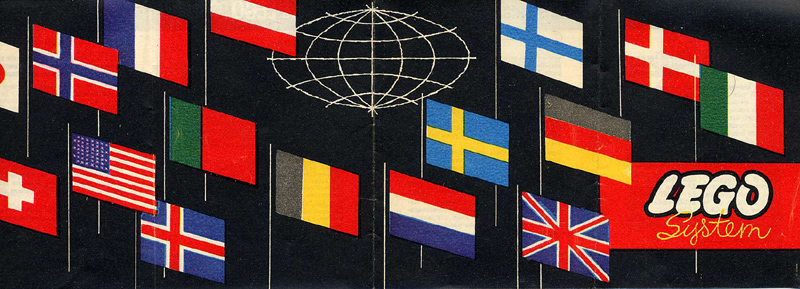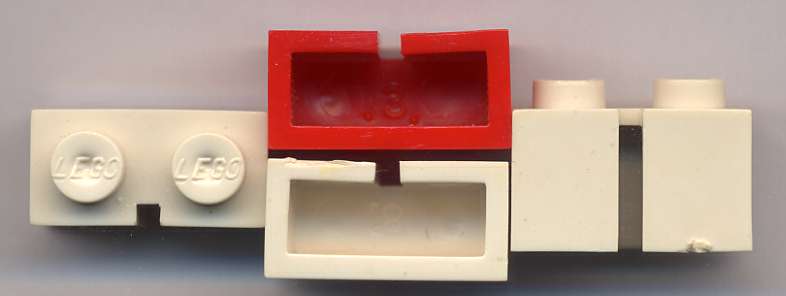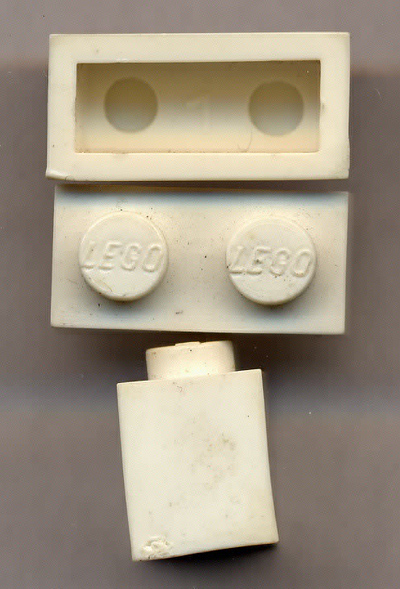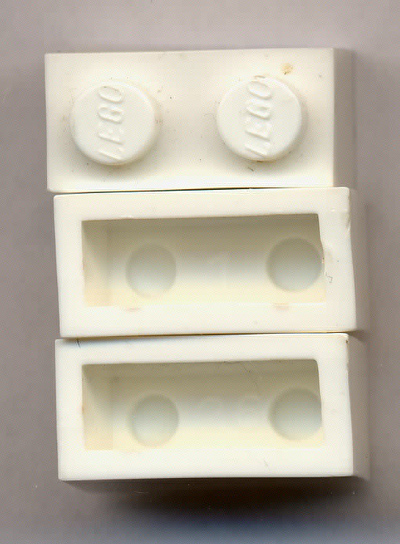

With this mold, the 1X2 brick was introduced in the LEGO Mürsten system.
The brand name "LEGO" was conspicuously carved in the mold, occupying most of the inside bottom but is much smaller than in the other bricks molded at this time.
No mold numbers are engraved.
Looking from beneath, the interior angles between the walls are sharp. Looking into the brick interior, thin longitudinal ribs will be noticed. These were probably carved in the mold to help with the ejection process.
This is the probably the only 1X2 mold used for colours that had seemingly been abandoned by 1953, such as light green and marbleized.
Mold units were made at this time to produce both the single slotted bricks and the double-slotted bricks.
NOTE: In LEGO bricks the slots are molded and not cut and thus the same molding unit always produces the same type of slotted brick.
"LEGO" script smaller than in vs01a and identical to the engraving in 2X3vs01b and 2X2vs02.
No mold unit numbers are engraved.
Looking from beneath, the interior angles between the walls are rounded. The interior ribs are transversal and not longitudinal (one is clearly seen in the left part of the interior of the right brick in the figure at left).
Mold units were made at this time again to produce both the single slotted bricks and the double-slotted bricks.
A new 1X2 mold was made in the "dogbone" era, possibly to accomodate a larger demand.
No mold numbers. Pip on the side of the brick. Seen from beneath, inside corners are sharp angles.
Although the dogbone LEGO logo is absent (in fact the bricks are unmarked and clones can easily mimick them), the studs of this type depict the same unique characteristic as the other types listed above: the sides of some studs are seen to be taller than the top - as is the case for the two studs of the blue brick depicted in the image at left. This is caused by ejector pins in the cavity of the mold, one over each stud.
Mold units were made at this time to produce both types: the single slot brick (mold nr 1) and the double slot brick (mold NR 2).
The bricks are marked in the interior with the so-called LEGO dogbone logo, occupying the whole bottom. Only seen double slotted but it is likely that molds for both versions were produced at this time.
No mold numbers. Mold pip on the side of the brick.
Sides of some studs are seen to be taller than the top - as is the case for the two studs of the brick depicted at left. This is a result of using ejector pins on the cavity side of the mold, one over each stud top. The marks are seemingly caused by an intrusion of plastic on the periphery of the ejector pin tops.
NOTE: This version must be unusual and was pointed to me by fellow collector Richard Bintanja. It is possible that it was introduced to fight very similar unmarked clones. But the logo is barely visible and the mold was soon replaced by the next one, which may account for its rarity.
At the end of 1954 or the beginning of 1955 molds started being made for a new version with the logo on the studs and a mold code inscribed in the interior, at the center (see figure below). The code was made of a numeral and eventually one or two dots differently positioned around the numeral. There are also unnumbered bricks (probably corresponding to code "0"). These bricks were used in the small parts boxes sold from 1955.
There were at least two molds producing up to 28 bricks each. They all have ejector pin marks under the studs. The type with numerals and dots has the injection pip on the frontal edge; another type, marked with numerals only, is probably more recent and has the pip on one of the side edges.
The molds were manufactured to produce bricks of two sorts: single slot and unslotted- the first 1X2 molds so designed. At least four mold units (5-no.dots, 6, 8, 9) produced unslotted bricks.
The studs are full and as a consequence of faster cycles, the plastic collapses inwards resulting in concave stud surfaces.
NOTE: These were the bricks used namely with Set 1236 (Garage with door) and sold for use with set 1235 (Automatic garage door) as the older door frame needed slotted bricks as retainers.

The problem with the concavity of the stud surfaces on high speed injection molding, seen e.g. on the previous version pictured above, called for thinner stud walls, and so in the first molds for non-slotted bricks produced by LEGO, the studs were hollowed.
The fourth version of the 1X2 brick was introduced in 1956. The hollow has a diameter of ca 3mm.
As in version 03 of this brick, the LEGO logo is lengthwise on the studs. Mold numbers seen were "1" to "28" and there are also unnumbered bricks. Several molds were made and numbers identifying mold units were repeated. Molding pip on the side corner.
Bricks of this type were the first seen sold in Portugal in 1958 but were replaced with the next version circa 1960.
The fifth version of the 1X2 brick is almost identical to version 04 but the LEGO logo on the studs is now sideways. Mold numbers seen are "1" to "47" and there are also unnumbered bricks. Molding pip on the corner.
Bricks of this type were certainly introduced after the new "Pat Pend" 2X2, 2X3 and 2X4 bricks with tubes had been in widespread use for several years.
 |
 |

New molds were made circa 1960. These are distinguished by the smaller diameter hollow of the studs, correcting a possible fragility of the previous version.
Stud hollows are encircled by a ring, likely the imprint of ejector pins in the mold.
The first mold or molds were identified by a number only, subsequent molds identified by a code consisting of a number and a letter on opposite sides of the underneath.
On the image are compared, on the left side, 1X2vs05 with, on the right and below, the new 1X2vs06.i
The introduction of this type is part of a cycle including 2X4vs06 and 2X2vs06, where all stud hollows were reduced for increased resistance.